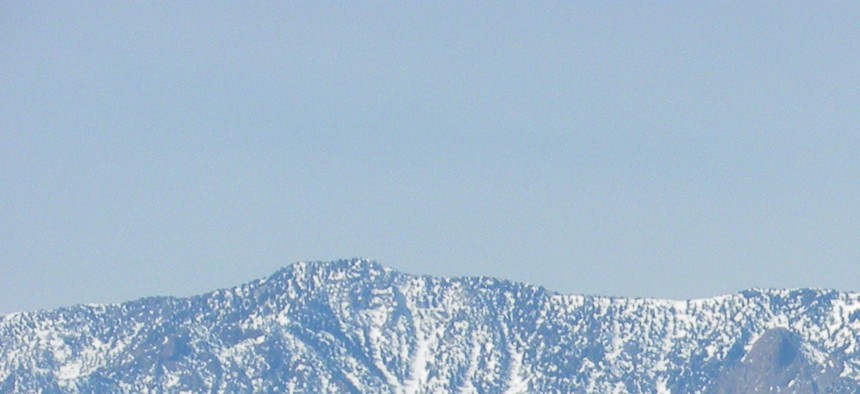
The artist defaced Telescope Peak in Death Valley National Park. Wikimedia Commons
Graffiti Artist 'Creepytings' Is Defacing National Parks
As long as National Park Service budgets shrink, vandalism is going to be a feature of our favorite natural spaces.
Make no mistake: Casey Nocket has earned all the ire coming her way. On Tuesday, Modern Hiker called her out for painting graffiti in maybe a dozen different national parks. The publication did not take kindly to the lowbrow portraits she painted near Telescope Peak in Death Valley, on an overlook at Crater Lake, and along the Mist Trail in Yosemite National Park, among other pristine places. The Internet quickly piled on . Nocket has since taken down the Instagram feed where she documented her tagging (under the name "Creepytings" ). But she's apparently taken to Tumblr to defend herself from her critics, answering one with, "if banksy did it u’d have a hardon" ( #betterthanbanksy ).
For now, Nocket appears to enjoy playing the villain , although she may savor that role less when the attention takes the form of federal misdemeanor charges . Since she makes her painting in acrylic (and not, say, chalk), it will take work for park rangers to remove them, but she hasn't permanently defaced nature. We can leave it to art history to judge whether her national-park paintings across the West stand up as a credible act of art and appropriation. A Yosemite National Park investigator posting on the Reddit thread about Nocket reminded angry readers that she deserves a fair hearing: "Due Process, Due Process, Due Process."
Folks who've made up their mind about Nocket should reserve a little bit of the blame for Congress. That was a point that New York Times business columnist Joe Sharkey made back in May of 2013 , after he discovered that an artist (or crew) called "Soma" had tagged Saguaro National Park. That's right: A street artist tagged a bunch of cacti.

A stern sign in Canyonlands National Park, 1972. ( Flickr /U.S. National Archives)
"Staffing at the National Park Service is scandalously tight—Park Rangers work hellacious hours, and they do it from a deep sense of duty," he wrote on his personal blog . Furious about the vandalized saguaros, Sharkey turned his wrath toward our elected leaders:
This might be a very good opportunity, then, to address some of the effects on beloved institutions like the National Parks created by the budget shenanigans perpetrated by the now-thoroughly-disreputable U.S. Congress, specifically sharp budget cutbacks caused by sequestration at government agencies like the National Park Service. If the National Park Service is upset about not getting out front on this story yesterday, when the media interest became intense, the opportunity exists today and beyond to address the very real consequences of severe budget cutbacks in our glorious national parks.
Is Creepytings one of those very real consequences of budget cuts and sequestration? No one would argue that more robust staffing in the parks service might prevent a vandal from making nature her canvas. But Casey Nocket isn't just a street artist who vandalized a rock in one park: She's a serial defacer who has tagged possibly a dozen or more national parks across the nation. And her misdemeanors only came to light through journalism—not through routine park maintenance at any one of a dozen different parks.
"[C]rippled by compounded budget cuts over recent years": That's how the National Parks Conservation Association describes the financial state of the U.S. National Park Service. While nature got a small bump in the 2014 federal budget, that came after a 13 percent decline in the National Park Service budget between 2010 and 2013.
In a way, this is a real shock. National parks are a national no-brainer. After the government-shutdown fiasco last year, one poll found that 82 percent of voters described the episode as a reminder of why national parks are important. That's consensus across partisan lines ( 90 percent of Democrats and 74 percent of Republicans dig parks. (Who are these voters who don't?)
Three out of four Americans said that the shutdown had a negative effect on local economies near national parks. That drives at another point about the boon of national parks, as this helpful chart demonstrates :

Maybe it should come as no surprise that Congress can't get behind a nationally beloved program with a return on investment that can be measured in dollars and, like, transcendental joy. Congress couldn't agree on a bill declaring Casey Nocket a public nuisance.
Vandalism is always a threat at national parks. There's always going to be a Creepytings creeping around. But as long as the National Park Service finds its resources spread so thin, vandalism is going to be a feature of our favorite places in nature.






